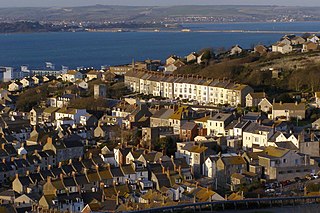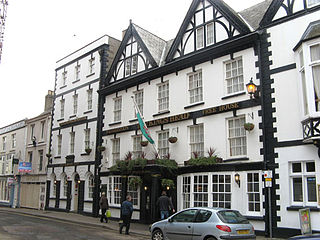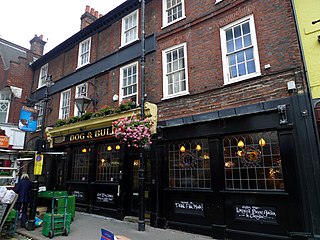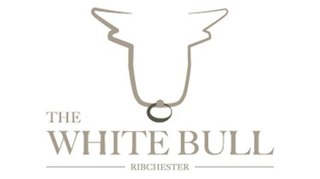
Ludlow is a market town and civil parish in Shropshire, England. The town is significant in the history of the Welsh Marches and in relation to Wales. It is located 28 miles (45 km) south of Shrewsbury and 23 miles (37 km) north of Hereford, on the A49 road which bypasses the town. The town is near the confluence of the rivers Corve and Teme.

Keswick is a market town and civil parish in the Cumberland unitary authority of Cumbria, England. Historically, until 1974, it was part of the county of Cumberland. It lies within the Lake District National Park, Keswick is just north of Derwentwater and is four miles from Bassenthwaite Lake. It had a population of 5,243 at the 2011 census.

Fortuneswell is a village in Underhill on the Isle of Portland, in Dorset, England. It lies on steeply sloping land on the northern edge of the island, known as Underhill, where Chesil Beach connects the island to the mainland. Adjoining Fortuneswell are Chiswell to the west and Castletown to the north. Fortuneswell occupies the steeper land above sea level, whereas Chiswell and Castletown occupy flat land close to sea level, next to Chesil Beach and Portland Harbour respectively. Fortuneswell has a main shopping street, and along with Easton, is the main hub of the island's activities.

Nettlebed is a village and civil parish in Oxfordshire in the Chiltern Hills about 4+1⁄2 miles (7 km) northwest of Henley-on-Thames and 6 miles (10 km) southeast of Wallingford. The parish includes the hamlet of Crocker End, about 1⁄2 mile (800 m) east of the village. The 2011 Census recorded a parish population of 727.

Mells is a village and civil parish in Somerset, England, near the town of Frome.

The Bull Inn, also known as The Bull at Sonning or just The Bull, is an historic public house — now also a restaurant and hotel — in the centre of the village of Sonning in Berkshire, England.

The Feathers Hotel is an historic inn in Ludlow, Shropshire. Its imposing half-timbered frontage was constructed in 1619, over an earlier core, for a local lawyer, Rees Jones. John Newman describes the hotel as a "prodigy" of Tudor architecture and it is noted for its Jacobean furnishings. It is a Grade I listed building, listed on 15 April 1954, and is one of approximately 500 listed buildings in Ludlow, but one of its best known.

The Mermaid Inn is a Grade II* listed historical inn located on Mermaid Street in the ancient town of Rye, East Sussex, southeastern England. One of the best-known inns in southeast England, it was established in the 12th century and has a long, turbulent history. The current building dates from 1420 and has 16th-century additions in the Tudor style, but cellars built in 1156 survive. The inn has a strong connection with the notorious Hawkhurst Gang of smugglers, who used it in the 1730s and 1740s as one of their strongholds: Rye was a thriving port during this period. Some of the smugglers, their mistresses and other characters are reported to haunt the inn.

The Pied Bull Hotel is located at 57 Northgate Street, on the corner of King Street, Chester, Cheshire, England. It is recorded in the National Heritage List for England as a designated Grade II* listed building.

The King's Head Hotel is a hotel standing opposite the Shire Hall in Glyndŵr Street, Agincourt Square, Monmouth, Wales. It dates from the mid-17th century, and as one of the major inns in Monmouth was reputedly visited by Charles I of England in 1645. It has a fine black-and-white painted stone façade and became an important posting inn in the late 17th century, with a yard through an archway where visitors' horses could be stabled and where regular coach services called. In the 18th and 19th centuries, stagecoaches for London left from the inn. The range of buildings along Agincourt Street now includes the former Monmouth Bank and the County Club, while the inn itself is now part of the J D Wetherspoon pub chain. It is one of 24 buildings on the town's Heritage Trail and is a Grade II* listed building.

The Royal Pavilion Tavern, commonly known as the Pavilion Tavern or Pav Tav and since February 2022 as The Fitz Regent, is a pub in the centre of Brighton, part of the English coastal city of Brighton and Hove. Converted from a house into the Royal Pavilion Hotel in the early 19th century, its original role soon changed from a hotel to a pub, in which guise it remained until its closure in September 2019. It reopened under its new name, but still in the ownership of the Mitchells & Butlers chain, on 13 February 2022. The building was also used as a court for several years early in its history, and prominent local architect Amon Henry Wilds was responsible for its redesign as a hotel and inn. English Heritage has listed the building at Grade II for its architectural and historical importance, and it stands within a conservation area.

The Bull and Mouth Inn was a coaching inn in the City of London that dated from before the Great Fire of London in 1666. It was located between Bull and Mouth Street in the north and Angel Street in the south. It was once an important arrival and departure point for coaches from all over Britain, but particularly for the north of England and Scotland. It became the Queen's Hotel in 1830 but was demolished in 1887 or 1888 when new post office buildings were built in St Martin's Le Grand.
Ludlow is a civil parish in Shropshire, England. It contains over 420 listed buildings that are recorded in the National Heritage List for England. Of these, nine are listed at Grade I, the highest of the three grades, 25 are at Grade II*, the middle grade, and the others are at Grade II, the lowest grade. Most of the listed buildings are grouped around the centre of the town, from a line stretching from Castle Square, along High Street and King Street to Tower Street, and southwards to the River Teme, and to the north along Bull Ring and Corve Street.

The Dog & Bull is a public house in Croydon, England. It is a Grade II Listed, 18th-century building with a 19th-century frontage in Surrey Street, on the site of a previous 12th- or 13th-century inn called The Bell.

The White Bull is a public house and inn on Church Street in the English village of Ribchester, Lancashire. It dates to 1707 and is a Grade II listed building with some unique exterior features.

Whitefriargate is a pedestrianised street in the Old Town area of Kingston upon Hull, in the East Riding of Yorkshire, England. During the 20th century, it was one of the main shopping streets in the city centre, but some of the major stores have closed down, which has been attributed to out of town shopping centres. However, the Street still provides a useful link to and from the old town of Hull.

Public houses, popularly known as pubs, are a significant feature of the history and culture of the English seaside resort of Brighton. The earliest pubs trace their history back to the 16th and 17th centuries, when present-day Brighton was a fishing village. Several coaching inns were founded in the 18th century as transport improved and communications with other towns developed, and around the same time other pubs became established in the fashionable Old Steine area in Brighton's early years as a resort. Many new pubs, originally beerhouses, were established after an Act of Parliament in 1830 loosened restrictions; two of these "Beerhouse Act" pubs remain in business. In the following decade the opening of Brighton's railway station provided another major boost to the pub trade, and by the late 19th century there were nearly 800 licensed venues in the town. Numbers declined gradually—as late as 1958 there was said to be "one pub for every day of the year"—and by the early 21st century around 300 pubs were still trading, with others having closed but surviving in alternative use.

Clarence House, previously the New Inn (1785–1830) and the Clarence Hotel (1830–1972), is a former coaching inn and hotel in Brighton, part of the English coastal city of Brighton and Hove. The only surviving coaching inn of many which used to stand on North Street, Brighton's main commercial thoroughfare, it retains much of its original "severely plain" Georgian appearance, with Classical features and mathematical tiles; but the interior has been changed since its closure in 1972 and conversion into a mixed-use commercial building. The four-storey structure, which is in a conservation area and which has been listed at Grade II by Historic England for its architectural and historical importance, is empty and has been vandalised and squatted repeatedly, but planning applications were raised in 2021 and 2022 for the creation of two flats and a new restaurant within the building.


















